An Atmosphere of Departure and Two Speeds, Korean Style: Where is North Korea Heading?
The Country Is Changing
Not that it has ever been static, but within the few months between my travels to North Korea in spring and autumn of this year, the country has changed to the degree that even a foreign visitor cannot avoid noticing. While in April, everyone seemed to be somewhat tense and edgy, unsure about what would happen under the new leader and torn between hope and concern, by September, the atmosphere was almost upbeat and optimistic. It is even now clear which is the new standard badge (the big red flag with the two leaders), and everyone is waiting patiently to receive his own. Admittedly, the season is nicer in the fall than in the spring: the temperature is warmer, the landscape greener, and food from the new harvest is on the table, while hard manual labor in the fields and the cold of winter are still a few weeks away. But there is more.
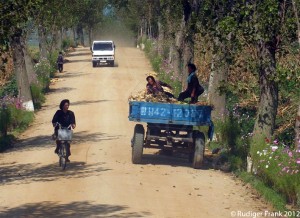
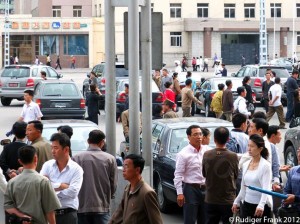
This may just be the beginning. The people in the DPRK have noted a new wind blowing from the top and seem to be welcoming it. In some cases, we have even seen an instant reaction, like the small but growing number of short haircuts among women that I noticed on this trip, particularly in Pyongyang. With remarkable speed, the new leader’s wife Comrade Ri Sol Ju has become a fashion icon in a country that previously has been rather conservative regarding hairstyle and dress code. Kim Jong Un has been in power for nine months now. If we can believe the image produced by the DPRK state media, he started showing his own personality earlier than expected and went beyond a mere preservation of the status quo. While continuity is being emphasized, his public scolding of officials at Mangyŏngdae, the somewhat bizarre Disney performance in July, the quick ending to the career for rising star Vice Marshal Ri Yong Ho, the growing and shared media spotlight on top-level officials such as Premier Choe Yong Rim and Vice Chairman of the Party’s Central Military Commission Choe Ryong Hae, and not least, the appearance of a first lady both in public and in the media are markedly new signals.
In many regards, Kim Jong Un is just harvesting what had been sown years ago, be it long-term macroeconomic trends like marketization, monetization and intensified foreign trade with China, or specific construction and renovation projects. But as noted by leading Russian expert Georgy Toloraya over beers in Pyongyang, in traditional East Asian fashion, North Koreans regard the new leader’s fortune (regardless of its causes) as a sign of approval from Heaven. What a contrast to how his father’s rule started—with the Arduous March.

One noticeable difference on this trip was that the number of sales booths selling bread, soda, pingsu (water ice) and cigarettes has multiplied; they can now be found at almost every intersection in the capital, as well as in provincial cities and the countryside. Particularly in the big cities, there is seemingly an atmosphere of departure. Not only the simple stalls, but also the more sophisticated sangjŏm (literally: “shop”; usually housing a store on the ground floor, and a restaurant and a sauna on the top floors) seem to have mushroomed in the past months. Again, Pyongyang is taking the lead, but Namp’o, Sariwŏn and Kaesŏng also seem to be catching up. Prices are horrendous; three kilograms of apples cost as much as one (official) month’s wages. But the fact that even things like bananas are being sold is remarkable. The problem does not seem to be access anymore, as was the case in classical socialist economies. All that counts now is having the right amount of the right currency. This is hard enough for many, to be sure. But as much as this is a new type of challenge for many North Koreans, it is not uncommon in Western market economies. The bottom line: the DPRK is catching up.
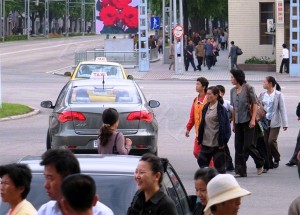
I also noted that the number of taxis I saw in Pyongyang was the most I have ever seen, and the diversity in clothing for both men and women has increased markedly. Inline-skating is the latest trend among kids and can be observed on squares on both sides of Taedong River, including Kim Il Sung Square. In the Pyongyang Gold Lane, a bowling alley that the Eternal President himself once visited, youngsters in t-shirts and sweaters enjoy bowling and play billiards and table tennis. Some of them even spend their hard currency at slot machines. The cafeteria sells opulent meals, of which, much (including strips of beef) is left behind by North Korean customers.
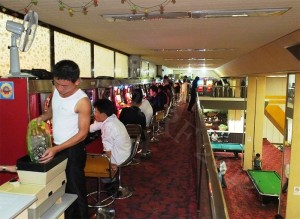
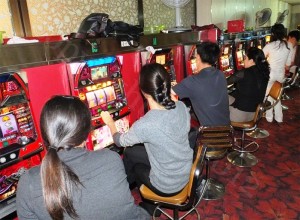
Museums and other places that are visited by foreigners now also inevitably have shops; visitors with hard currency can even buy souvenirs and snacks on the top floor of the Grand People’s Study House. For someone like me who twenty years ago had to walk a few miles from his dormitory to the Rakwŏn Store in East Pyongyang or the Koryŏ Hotel to be able to spend some Western money, this is a remarkable development. If you have the cash, you can even buy a small brush painting by Chŏng Chang Mo, one of the country’s leading artists, for 1,400 EUR. There are not one but at least two cash cards (the red-blue narae issued by the Foreign Trade Bank and the golden koryŏ issued by Koryŏ Bank) that can be used in taxis and in dedicated shops, not to mention the number of mobile phones has long passed the one million mark.
The number of traffic lights replacing the “Flowers of Pyongyang” (a.k.a. traffic ladies) seems to have increased further, and smaller traffic jams are frequent. The streets are now dominated by a great variety of passenger cars manufactured both at home (Pyonghwa Motors) and abroad—still a far cry from Seoul’s crowded highways, but already much more diverse regarding represented brands. The number of yellow license plates, indicating “private” ownership, is increasing, although white state owned license plates still dominate, along with black military ones. The old trolley buses, some of which have run millions(!) of kilometers (you can easily tell: a red star is painted on their side for each 50,000 kilometers they have survived) are being replaced by new ones.
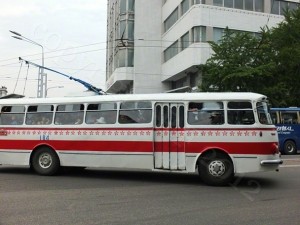
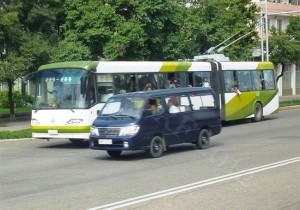
The newly built and meanwhile opened Mansudae apartments are not only a good example of modern city architecture, they also tell the story of a new management philosophy: Kim Jong Un allegedly informed the builders that he would prefer quality over speed, and that there was thus no need to finish everything rashly in time for the April 15th centenary of his grandfather. This does not seem to have been the case for all projects, however; the new statues of the two previous leaders on Mansudae Hill that were unveiled in April have been covered in white cloth since September 11.
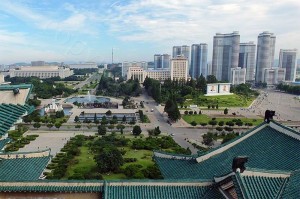
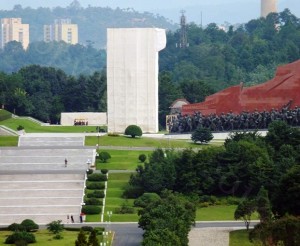
On the ideological side, we note an ongoing renovation of slogans and monuments. Unlike in April, when Kim Jong Un was referred to as the “dear respected comrade” on most banners and steles, he is now frequently called “great sun of songun” and “Great Leader.” While the former is at least in part different from “great sun of the 21st century,” a title used for his father Kim Jong Il, the latter term (widaehan ryŏngdoja) is identical. Who would have thought that within less than a year, Kim Jong Un would assume the same status as his father?
Another interesting detail concerns the very appearance of the slogans. Traditionally, they have been painted in white letters on a red background. Some were carved in stone above the entrance to public buildings, and often the carvings were painted in red or more recently, in a less conspicuous gold-bronze. In September, however, I noticed that in a few cases, the color was skipped altogether. Unless there was simply a shortage of paint, this more subdued and modest (for North Korean standards) new appearance invites further speculation about the new leadership style.

Last but not least: the Arirang mass performance. While it did take place again this year, the rumor is that from 2013, it will be completely updated or even changed. I attended two previous performances (2005 and 2010) and noted this time that there was an absence of any aggressive messaging. The only weapons shown were the two handguns that Kim Il Sung had received from his father along with the slogan “aim high.” The chapters on Chinese-Korean friendship and on unification were still included, but the main focus was on nationalism and the country’s economic and social achievements.
Pyongyang First?
Like many other visitors have reported recently, I was impressed to see the widening gap between Pyongyang and the countryside. Paying particular attention to the nation’s capital is neither a new policy nor is it limited to the DPRK. But my impression was that stagnation in the countryside regarding road conditions, houses, service facilities, clothes and overall standard of living stood opposed to almost breathtaking development in Pyongyang. How will North Koreans react? We should not necessarily assume that the widening gap will be regarded negatively. Deng Xiaoping himself had coined the idea of “two speeds,” arguing that it was alright for one part of China to achieve prosperity first as long as the other would have a fair chance to follow.
Perhaps we could even argue that such huge differences in affluence within the country smartly divert attention away from the outside world. Rather than dreaming about life in Shanghai or Seoul, young and ambitious people in North Korea can dream about the lights of Pyongyang. Besides, this makes living in the capital an even bigger privilege and relegation to the provinces a more severe punishment.
Developmental economists will be familiar with the debate of balanced versus unbalanced growth. It seems that at least for some time, the DPRK leadership has decided in favor of developing one city as best as they can, rather than spreading their scarce resources across the country with a watering can and achieving no visible results. With some optimism, as a next step we could expect a spill-over effect to the provincial cities and the area around the capital. My evidence so far is rather arbitrary, so due caution is advised. Nevertheless, I dare say that I noticed slight improvements in the larger cities along my travel route in September; most notably, the above mentioned sales booths and a number of newly opened siktang (restaurants) and sangjŏm. Not only do they indicate more diversity on the supply side, they also imply that people have more money to spend. In any case, the appearance, the attitude and the body language of Pyongyangites is still notably different from the rest of the country.
Reforms In Agriculture: Catching Up?
Is the countryside next in line for a major improvement? Or was the beautification of Pyongyang a deliberate step to make up for an expected welfare boom among farmers?
If the rumors spread by Reuters on September 24 are true and reforms in agriculture will once again take place after a decade, then we need to ask what the leadership wants to do about inflation this time. External conditions for a reform effort are not necessarily better than in July 2002: George W. Bush is long gone, but Barack Obama has not been as forthcoming as many had hoped; the government in Seoul is much less supportive than the Kim Dae Jung administration; and the abduction issue still stands in the way of normalization with Japan. On the other hand, China’s potential to help has grown; there is a new young leader in Pyongyang; and the past decade of ups and downs have taught painful but valuable lessons to the DPRK’s economic policymakers.
No matter what the balance is: a few structural restraints remain unchanged. North Korea is not an agricultural society. A liberalization of prices and production decisions will benefit the farmers, which by way of incentives might eventually lead to increases in productivity and output. But in the DPRK, farmers are a minority. Given the country’s chronic shortage of staple food, after liberalization, prices will soon skyrocket and fill the pockets of the few producers (which is good) at the expense of the majority who are consumers (which is very bad). In China in the early 1980s, it was the other way round—the vast majority was farmers who saw their incomes exploding, while the minority population of the cities was protected by the state’s subsidies, which were in turn financed by income from rural taxes.
But there is no way the Chinese blueprint can work in North Korea. Income from taxes on farmers will be too low, and demand for subsidies by urbanites will be too high. There are two ways out of this dilemma: either the agricultural reforms are flanked by similar measures in industry, so that the urban incomes can rise along with food prices; or there is a large injection of cash to allow the state to import food for a few crucial years. This would reduce upward pressure on domestic food prices and/or finance subsidized food distributions to the urban population until domestic production has reached the level of market saturation. This does not only sound risky, in fact it is.
The announcement at the September 25 session of the parliament to extend compulsory secondary education by one year fits very well into this analysis. Note that the extra year is explicitly not to be spent on ideology; students will be taught “general basic knowledge and basic knowledge of modern technologies” (KCNA, 25.09.2012). Kim Jong Un kills two birds with one stone: true to his promise to improve the people’s living, he gives a gift to North Korean parents who, like their compatriots to the South, are highly concerned about getting their offspring the best possible education; he also invests in training a future workforce for the new and dynamic domestic industry that will form the backbone of a reformed, or rather, call it “adjusted,” national economy. Experience tells us that the parliament might also have deliberated on a few more issues, about which we will hopefully learn in the next few weeks.
To conclude, we should give the new leader due credit for having acted faster and more decisively than we had expected. The direction he is headed seems to point toward pragmatism and economic development. Meanwhile, the capital has turned even more into an object of admiration or envy for the rest of the country. The stage has been set; expectations have been created. Now comes the tough part: finding ways to deliver on the economic front while maintaining stability of the political system and managing the new diversity in DPRK society. Investment in education is not the worst idea in this context. However, to cure the disease without killing the patient won’t be easy.
